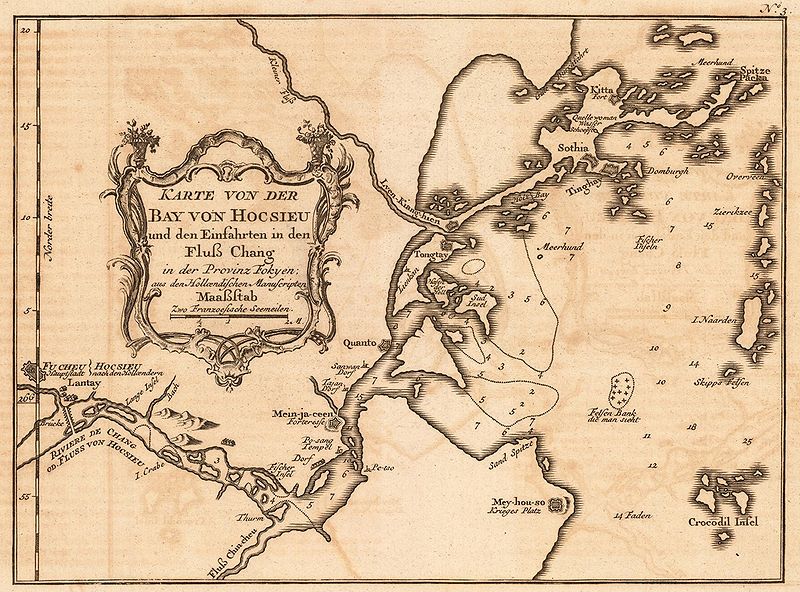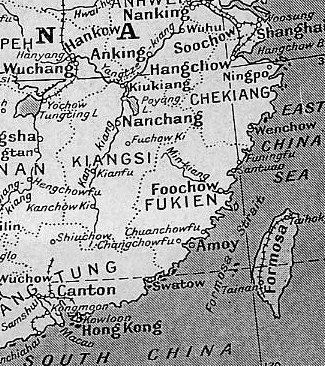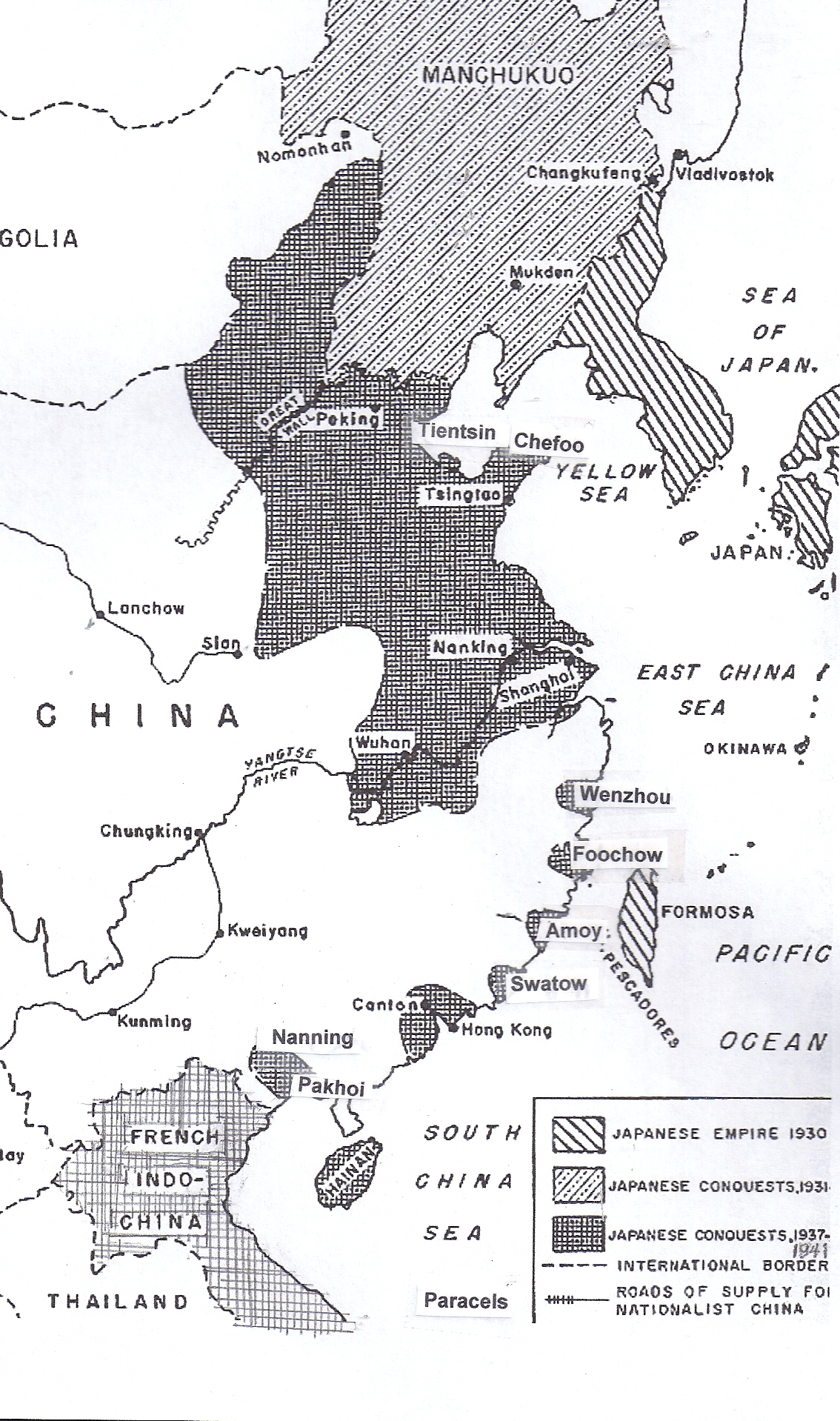RISING STORM - THE IMPERIAL JAPANESE NAVY AND
CHINA
1931-1941
 (Old Dutch map of Foochow (Fu Cheu) showing its location
on the Min River Estuary)
(Old Dutch map of Foochow (Fu Cheu) showing its location
on the Min River Estuary)
The Seizure of Fuchow (Fuzhou) - 1941
© 2012 Bob Hackett
220-280 AD:
During the Three Kingdoms Period, southeast China is under the control of Eastern Wu (229-280). The Fuchow area shipyard serves the coastal and Yangtze River fleets.
282:
During the Jin Dynasty (265–420), the artificial East Lake and West Lake (which no longer exist) are constructed in Ye, as well as a canal system. Modern Fuchow (Fuzhou), capital of Fukien (Fujian) province, grows around these three water systems.
725:
The city is formally renamed Fuzhou.
1368-1644:
The Ming government grants Fuchow a monopoly over trade with the Philippines.
1842:
A peace treaty concludes the First Opium War with Great Britain. Fuchow becomes one of the five Chinese treaty ports and is completely open to Western merchants and missionaries.
23 August 1884:
The Battle of Fuchow begins between the Qing Dynasty's Fujian Fleet and the French Far East Fleet. The French completely destroy the Fujian Fleet in Mawei Harbor. Later, Fuchow declines in importance due to sand bars and shallows in the Min River delta on which it is built. Fuchow's rugged interior largely isolates it from the rest of China.
1932:
Political unrest in China calls for constant vigilance by the United States Asiatic Fleet to protect American lives and property. Destroyers and gunboats TULSA (PG-21) and SACRAMENTO (PG-19) are assigned to Fuchow and the south China seaports of Swatow and Amoy.
1937:
Japanese redidents in Fuchow are placed under the protection of Rear Admiral (later Vice Admiral) Okuma Masakichi's (37)(former CO of YAMASHIRO) DesRon 5 composed of flagship light cruiser YUBARI, destroyer ASAGAO and DesDivs 13 and 16.
 (DesRon 5's flagship YUBARI)
(DesRon 5's flagship YUBARI)
7 July 1937: The Marco Polo Bridge Incident ("First China
Incident"):
Hun River, Lukuokiao, China. Imperial Japanese Army (IJA) troops on night maneuvers at the Marco Polo Bridge fire blank cartridges. Chinese troops across the river think they are under attack. They fire live rounds back, but do not cause injuries. At morning roll call, the Japanese discover a soldier missing and assume the Chinese have captured him. The Japanese demand entry to
the Peiping (Beijing) suburb of Wanping to look for the soldier, but the Chinese refuse. The Japanese then shell the city. An undeclared war on China begins.
17 August 1937:
Japanese residents in Fuchow begin evacuation by order of the Foreign Minister. All reach Formosa safely.
 (Fuchow's (Foochow) coastal location between Shanghai and Hong Kong,
also showing Amoy, Ningpo, and Wenchow)
(Fuchow's (Foochow) coastal location between Shanghai and Hong Kong,
also showing Amoy, Ningpo, and Wenchow)
13 April 1938:
Two floatplanes from battleship KONGO bomb Fuchow.
13 May 1938:
The fall of Amoy (Xiamen) threatens the security of Fuchow.
23 May 1938:
The IJN bombards the port of Fuchow and Mei-hua, Huang-chi and Pei-chiao while Japanese planes harass Chinese forces.
31 May–1 June 1938:
Min River Estuary. Chinese gunboats FUNING, CHENING and SUNING defending Fuchow’s port and the Min River blockade line are bombed and sunk. Chinese ship CHUTAI, berthed at Nantai is damaged. The Chinese Navy's Harbor Command School, barracks, shipyard, hospital and marine barracks at Mawei also are all bombed.
June 1939:
The Japanese attack Fuchow and the port of Wenchow (Wenzhou) and lay mines at the ports.
1941:
Fuchow remains an important regional port with an airfield.
20 April 1941:
Japanese forces land at several places on the Fukien and Chekiang coast. They occupy Ningpo (Ningbo), Wenchow and Haimen, then advance into the interior.
20 April 1941:
Fuchow is occupied.
 (Captured Chinese Territories and Ports - 1941
(Captured Chinese Territories and Ports - 1941
Adapted from H. P. Willmott's "Empires in the Balance")
Late August-September 1941:
After destroying the supply route from Fuchow into China's interior, the Japanese no longer feel a need maintain troops there and evacuate Fuchow.
3 September 1941:
The Chinese recapture Fuchow, the first time they repossess a major seaport since the Japanese seal the south China coast.
December 1941:
After the United Kingdom’s Declaration of War on Japan, the British re-establish a Consulate in Fuchow. Western businessmen also re-establish a Foochow Club. American and British government undercover agents working under cover at the British Consulate assist in providing aid to the Nationalist Chinese resisting to Japanese forces in Fujian Province.
27 September 1944:
As part of Operation Ichi-Go, the last large-scale Japanese offensive in China in World War 2, the Japanese intend to isolate Fuchow and the Fujian Province corridor to Nationalist forces in western china and the wartime capital of Chongqing. The IJA 62nd Independent Mixed Brigade lands near Fuchow. The Brigade consists of the 410th 411th, 412th and 414th Independent infantry battalions and the 625th Independent infantry battalion plus the Brigade’s artillery group, engineer unit, communication unit, field hospital, veterinary unit and quarantine unit. Two battalion of the Chinese Ma Wei Fortress HQ Marine Unit and three regiments of the Chinese 80th division retreat after a few days of battle and the Japanese again enter Fuchow on 4 October 1944.
12 May 1945:
Chinese forces move into Fukien Province and seize the port of Fuchow. The Chinese also capture the airfield south of Fuchow.
-Bob Hackett
Back to Rising
Storm Page








